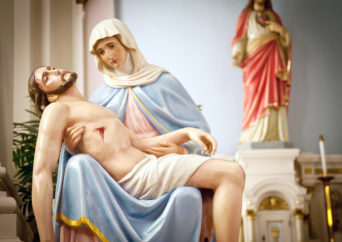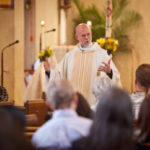
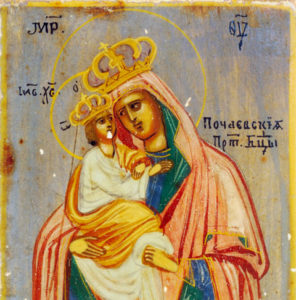
The Roman Catholic Church, established in the first century, is one of the oldest Christian traditions. One of the primary tenets of Catholicism is the belief in apostolic succession, which holds that the chosen successors of the Twelve Apostles have been granted spiritual authority passed down through the ages from Jesus Christ. This chain of power confers the pope with primacy and authority over church leaders and Catholic communities. Catholicism is the largest Christian tradition in the world. This site provides journalists with background information on Roman Catholicism and a brief guide to covering Roman Catholicism in the United States.
Background
Overview
Catholicism grew out of the notion that an unbroken line of apostolic succession dating back to Jesus’ original disciples (in particular, the apostle Peter) grants legitimacy to the church’s bishops and priests, as well as authority to the pope.
In 313 CE, the Emperor Constantine’s signing of the Edict of Milan — a letter proclaiming religious tolerance — and his subsequent conversion to Christianity officially gave rise to the church. The church then began to consolidate power, streamline beliefs and tax unincorporated pagan groups until some semblance of mainstream Christianity emerged. In 380, Christianity became the official religion of the Roman Empire.
Roman Catholicism didn’t emerge as a distinct brand of Christianity until Protestant denominations split off and developed their own distinctive beliefs and practices.
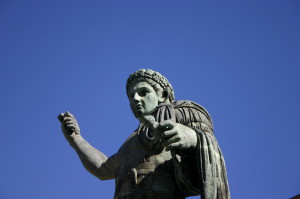
While the title of pope serves to identify the highest authoritative role in the Roman Catholic faith, the title pope is also used within another branch of Christianity — The Christian Coptic Orthodox Church Of Egypt.
Roman Catholics, American Catholics
During Pope John Paul II’s tenure from 1978 until his death in 2005, the number of Catholics in the United States grew about 30 percent, from just under 50 million to more than 65 million. That number had risen to 77 million by 2013. Despite these periods of growth, American Catholics continued to grow more restless, and even disillusioned. Experts say the early years of John Paul’s pontificate were marked by controversies and tensions with the American hierarchy and church leaders in the United States. Vatican efforts to rein in bishops and theologians who were seen as too liberal led to many headlines and books on the growing split between Rome and the United States. But experts say Pope John Paul’s great personal popularity largely overshadowed those conflicts for the average Catholic, and as he grew older American Catholics also tended to see him as an avuncular presence, more than as a taskmaster.
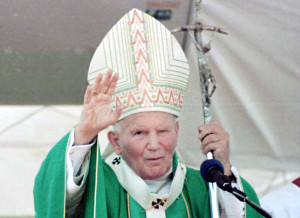
However, when the clergy sexual abuse scandal hit in 2002, the pope’s own popularity took a hit, as well as his track record. Several bishops were removed — including his point man in the United States, Cardinal Bernard Law of Boston — and the American church he largely shaped suffered a major crisis of credibility. Experts say the abuse crisis not only tarnished John Paul’s image, but it also exposed pre-existing rifts between what the pope preached and how Catholics behaved on a wide variety of issues, from birth control to abortion to gay marriage and other matters. Moreover, they say the scandal and resulting disillusionment with the institutional church that John Paul championed also contributed to a sense that Catholics would continue to go their own way on moral questions.
Example coverage
“Pope’s U.S. visit a chance to mend fences with conservatives” — Jan. 16, 2015, Scott Malone, Reuters
Pope Francis has electrified Roman Catholics in the United States with the open, accepting tone he has brought to the role, and his first visit later this year is expected to draw more than a million followers eager to set eyes on him.
The leader of the 1.2 billion-member church will also face a challenge in improving relations with conservative U.S. Catholics, who have expressed dismay at his shift in focus away from issues like abortion and same-sex marriage, which the church has long opposed but Francis contends need not obsess about. — Read more.
Vatican II
Stemming from a long history of religious councils, the Second Vatican Council, commencing in 1962 and ending in 1965, is viewed as a historic modernization of the Roman Catholic Church. Traditionally called under times of crisis, this council of Vatican II was convened under Pope John XXIII in peace time not for the specific intention of changing doctrine, but for the hope of reflecting on how the Catholic Church related to the modern world. The council was closed by his successor, Pope Paul VI, following the death of Pope John XXIII in 1963.
Major changes made under Vatican II include the changing of Mass language from Latin to a country’s native language(s), the switching of the altar’s orientation so that a priest now faced his parishioners during the Eucharist, and the allowance of Catholics to pray with those of other faiths. The council was also known for its role in recognizing and exhibiting acceptance and tolerance towards other faiths — notably Judaism and Islam — as well as other Christian denominations outside of Catholicism. The four sessions of Vatican II resulted in 16 religious documents implementing changes.
While Vatican II was widely praised for its acceptance of the modern world and other faiths, critics voiced discontent with the council’s failing to reform the concentration of power within the Roman Curia and the pope.
Example coverage
“Pope Francis declares two new saints, plays up Vatican II” — April 27, 2014, Patrick J. McDonnell and Tom Kington, Los Angeles Times
Pope Francis proclaimed sainthood Sunday for a pair of former pontiffs, John Paul II and John XXIII, thrilling multitudes who gathered in St. Peter’s Square and elsewhere to witness the double canonization.
It was the first time in the history of the Roman Catholic Church that two ex-popes were canonized in the same event.
Although the focus was on the late pontiffs, the elaborate ceremony and the global attention it generated seemed likely to provide another boost for the soaring reputation of Francis. The Argentine pope, who was elected last year, has become extremely popular with the faithful. — Read more.
Monasticism
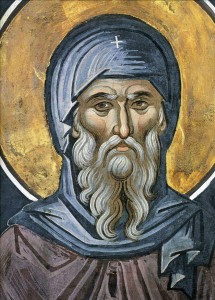
Derived from the Greek word monos, meaning “single” or “alone,” monasticism is commonly associated with devotees living a religious life led in contemplative solitude. Today, monasticism can be found not only within the Roman Catholic and Eastern Orthodox tradition, but also in other branches of Christianity, as well as within Buddhism. Historically, Christian monasticism began in the Egyptian and Syrian deserts in the fourth century under Saint Anthony, who exemplified a hermit religious life. However, as monasticism began to grow and move west, different orders — communities of devotees who follow the specific teachings or rules of a particular theologian — began to place monasticism within both an urban and communal setting. Within Catholicism, the monastic life is open to both men and women. Men receive the title monk if the have made a solemn vow to poverty, chastity and obedience and are a priest or deacon, or if they are a religious brother who has not been ordained. Women may be referred to as nuns when they have made a solemn vow and live in a confined “cloistered” life, while the title “sister” denotes a woman in a religious congregation that is not cloistered and takes simple vows, according to the Catholic Education Research Center.
As of 2012, there were approximately 55,045 sisters and 4,518 brothers (this does not include religious-order priests and deacons) in the United States and more than 500 religious orders, according to the United States Conference of Catholic Bishops 2012 report. Notable Catholic orders include the Jesuit, Carmelite, Benedictine, Franciscan, Trappists and Dominican orders.
Example coverage
“Monastic life could make surprise comeback in age of Twitter, Pope Francis aide” — July 5, 2014, John Bingham, The Telegraph
Monasticism could make an unlikely comeback because of pace of life in the age of Twitter, a leading aide to Pope Francis has suggested.
Archbishop Rino Fisichella, head of the Vatican’s evangelism department, said the constant presence of modern communications could make the ancient idea of a life of contemplation more attractive to people in the 21st Century than in the past.
The Archbishop was speaking as he arrived in Birmingham to join hundreds of young British Roman Catholics considering a call to a life as monks, nuns or priests at a weekend retreat to explore their vocation.
It follows signs of a revival of interest in the monastic life in recent years. — Read more.
What one businessman learned about success from Trappist monks
By Amanda Greene, Religion News Service
July 17, 2014
(RNS) Driving through the Spanish moss-draped gates of the Mepkin Abbey Trappist monastery in Moncks Corner, S.C., businessman August Turak felt as if he had just lost a whole lot of weight.
Not physical weight, but the weight of emotional and spiritual burdens.
After a corporate career with companies like MTV, Turak sold two successful software companies for $150 million, but shattering his ankle in a skydiving accident “brought me face to face with my own mortality.”
“I was one of those people who was very successful but felt empty inside,” said Turak, who became a lecturer at Duke University.
One of his students suggested he might find a way to fill that void at Mepkin.
Something in him changed during that first visit 17 years ago, and he’s returned three or four times a year from his home in Raleigh, N.C., wearing a gray smock garment and working alongside the monks.
With each visit he became more fascinated with how the elderly monks conduct their businesses. This month, Turak released his book, “Business Secrets of the Trappist Monks: One CEO’s Quest for Meaning and Authenticity.”
Some answers have been edited for length and clarity.
Q: What questions were you asking yourself as you watched the monks work?
A: I was thinking how do a couple of guys at the average age of 70 years old, who only work four hours a day and do so in silence, how do they manage to run 3,200 acres of land, a gift shop, library, conference center, an egg business, a timber business, a fertilizer business and a oyster mushroom business?
When people are passionately committed, they can do miraculous things. So I noticed that these guys are passionately committed to the high, overarching mission of selflessness, of something bigger than themselves.
Q: So can you share a few of the key secrets you learned?
A: Selflessness. When people feel like they’re on a mission from God, they accomplish incredible things and with a sense of satisfaction. We may think we want selfishness, but we’re happiest not when indulging but when we’re being selfless.
The real secret to the monks’ success was they were not in business at all. Great leaders are like that. The less I cared about making money, the more I make. Once people realize or sense that you’re not in it for yourself, they begin to trust and turn to you, and you have the power to achieve your goals and your mission. The amount of trust you gain is directly proportionate to how selfless you are in business.
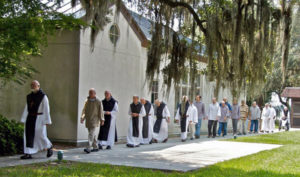
Q: You say the way the monks run things could apply to any business in America. Can you name a few that operate similarly?
A: I have a problem with Nike’s mission, “Just do it.” There’s not a moral component to Nike’s mission. For me, a mission has got to be worthwhile. It’s got to be higher. What people today are looking for is a noble mission.
It’s not a trade-off that the more good you do, the less money you’ll make. What Warren Buffett proves, what the monks prove, is the more ethically you behave, the more you grow and better you do.
Q: Everyone talks about finding work/life balance. How do the monks do it?
A: The monks don’t worry about balancing work and prayer; they are equally important. Work is a form of prayer, and prayer is a form of work. I found that one of the best praying times I had was while I was at work, standing at an assembly life.
Your ordinary life is your spiritual life. Every single challenge can be an opportunity for transformation if you look at it in the right way. You serve God through work and serve God through prayer.
Q: How does this philosophy of integrating prayer with work compare with prosperity gospel?
A: To me, this is the thing I’m always fighting against. The problem is that most people think that if I help this old lady up the street, I better buy a lottery ticket because I’m sure to win. But that philosophy short-circuits grace. I’m a grace guy, not a luck guy.
You have to give because that’s where you get your true joy and pleasure. As long as you’re trying to use God like a lucky rabbit’s foot to make you better in business, you’re not going to make it.
Q: Did all of these trips make you want to become a monk?
A: I do not have a vocation to become a Trappist. I am not a contemplative. I like to teach and talk, and if I would stick with the Catholics, I would be a Jesuit. Teaching and working with other people is far more my calling than being a contemplative.
It’s becoming more and more difficult to find someone who wants to dedicate themselves to religious principles. They seem to get a decent amount of guys, but they stay a year or two and then leave. In our society, that kind of life is just too difficult for many people. They’re like a beacon shining on the hill for the rest of us.
Core beliefs
Overview
Roman Catholics believe in Christ’s divinity, the Holy Trinity and the Bible. They also believe in the divine authority of the pope, the power of the saints to help believers, the concepts of Purgatory (an intermediate place of afterlife purification) and transubstantiation (the belief that blessed bread becomes Christ’s actual body during Eucharist).
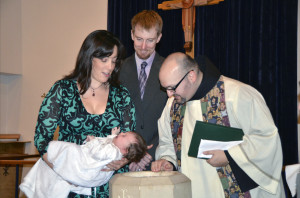
Catholics celebrate Eucharist weekly in a formal liturgy called Mass. Unlike Protestant and Orthodox ministers, Catholic priests take vows of celibacy, which are rooted in the early monastic orders. Other distinctive Catholic practices include the observance of seven sacraments (religious rituals), the veneration of saints and the use of rosary beads in prayer.
Sacraments
The Roman Catholic Church celebrates seven sacraments that serve as sacred ceremonies of recognizing God’s presence within a believer’s life. While some sacraments form core rites of passage within the Catholic faith, such as baptism or confirmation, others, such as the sacraments of holy orders or anointing of the sick, are received by only some believers depending on life experience. Moreover, while some sacraments, such as baptism or reconciliation generally occur at a particular age and in a particular sacramental order, other sacraments may be received at any stage of life.
The seven sacraments are:
BAPTISM
Baptism marks a believer’s welcoming into the Catholic Church and is signified through blessing by water and holy oil. Baptism is the first sacrament received, and for most Catholics, baptism occurs at infancy. This rite signifies the absolution of original sin and membership into the church.
RECONCILIATION
Also identified as “penance” or “confession,” this sacrament marks the oral acknowledgement of sins and request for forgiveness made by a believer to a priest. As believers confess their faults, priests are able to abolish these sins, serving as voice of Christ’s infinite forgiveness.
COMMUNION (EUCHARIST)
The Eucharist is celebrated in recognition of Jesus’s Last Supper in which Catholics receive the body and blood of Christ transformed from the bread and wine brought to the alter at every Mass. Dissimilar to other Christians, Catholics believe that in this sacrament, they receive the literal body and blood of Jesus Christ.
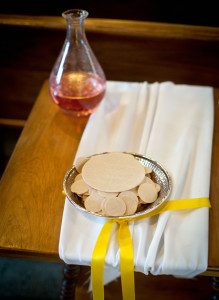
CONFIRMATION
The sacrament of confirmation marks the renewing of commitment and deepening of a relationship with God experienced at baptism. Celebrated by matured Catholics generally prior to adulthood, confirmation signifies the presence and guidance of the Holy Spirit – one entity of the Holy Trinity – in a believer’s life.
HOLY MATRIMONY
The sacrament of holy matrimony marks a believer’s formal and public union to a spouse. The sacrament celebrates the love a husband and wife offer one another, which Catholics believe mirrors the selfless love of God.
HOLY ORDERS
The sacrament of holy orders marks the commitment of one’s devote service to the Catholic Church through ordination as a bishop, priest or deacon.
ANOINTING OF THE SICK
Previously called last rites or extreme unction, the sacrament of anointing of the sick offers healing to those experiencing grave physical, mental or spiritual sickness.
Example coverage
“Catholic Parish located in Cy-Fair will use Latin sacraments” — Jan. 20, 2015, Lindsay Peyton, Houston Chronicle
Designs are in the final phases for a new Catholic parish in the Cy-Fair area devoted exclusively to the traditional Latin rite sacraments from the pre-Vatican II 1962 missal.
Regina Caeli or “Queen in Heaven,” Parish, will be the first such parish in the Archdiocese of Galveston-Houston in more than 40 years.
A groundbreaking ceremony was held Dec. 20, and after the celebration, the first phase of construction began – preparing the 40-acre tract of rural property in northwest Houston near Fairbanks North Houston Road. — Read more.
Holy days of obligation
A Holy Day of Obligation is a feast day particularly honoring God, the Blessed Virgin Mary or additional saints, that Catholics are duty-bound to celebrate through attending Mass and observing the feast day as a day of rest. Honored in a similar capacity as Sunday — the Sabbath — Holy Days are often celebrated throughout the week.
While church law has identified 10 Holy Days of Obligation, observation of these Holy Days varies from country to country as set by the country’s conference of bishops in agreement with the Holy See.
The United States recognizes six Holy Days of Obligation: Solemnity of Mary (Jan. 1), Solemnity of the Ascension (Thursday of the Sixth Week of Easter), Solemnity of the Assumption of the Blessed Virgin Mary (Aug. 15), Solemnity of All Saints (Nov. 1), Solemnity of the Immaculate Conception (Dec. 8) and the Solemnity of the Nativity of Our Lord Jesus Christ (Dec. 25).
Sin
While sin is a common word in Christian vernacular, within the Catholic tradition, sin is believed to be the transgression of God’s laws, disconnecting believers from God’s love and existing in differing severity. Catholics recognizes two types of sin, signifying the gravity of the fault — mortal sin and venial sin.
Mortal sin is the graver violation of God’s law and includes three aspects: a believer must have defied one or more of the Ten Commandments, he or she must have done so in full awareness and done so with deliberate intention. Examples may include murder, adultery or slander.
Venial sin is a slighter sin that hurts a believer’s relationship to God but may have been performed out of habit or without conscientiousness. Examples may include petty gossip, fighting with a relative or laziness. Both mortal and venial sins may be absolved through the sacrament of reconciliation. Catholics believe that a believer is unable to receive the sacrament of communion if they contain unconfessed mortal sins.
Example coverage
“Pope Francis defends church’s opposition to artificial contraception” — Jan. 16, 2015, Stephanie Kirchgaessner, The Guardian
Pope Francis issued a condemnation of liberal views on sexuality and birth control on Friday, telling an audience in the Philippines that today’s families were under threat from efforts to “redefine family” and a culture that lacked “openness to life”.
In advance of a vast rally on Sunday that could draw as many as 6 million people, the pope called on families to be “sanctuaries for respect for life”, and praised the church for maintaining its opposition to modern birth control, even if all Catholics could not live by such rules. — Read more.
3 ways the Vatican could allow divorced Catholics back to Communion
By David Gibson, Religion News Service
Oct. 13, 2013
(RNS) While the first months of Pope Francis’ pontificate have been marked by his attention to the poor and his “Who am I to judge” attitude on homosexuality, his pledge to tackle the ban on Communion for divorced and remarried Catholics could have the biggest impact for Catholics in the pews, especially in the U.S.
The current policy has caused what some call a “silent schism,” and bishops around the world concede that the ban has alienated untold numbers of Catholics and their families.
“I think this is the moment for mercy,” Francis told reporters when asked about remarried Catholics during a wide-ranging news conference on the plane back to Rome from Brazil in July.
Like the gay issue, Francis seems to favor a more pastoral approach to the equally perplexing question of “invalid” marriages — couples who remarry outside the church without getting an annulment, or those who do not get married in church in the first place.
In both cases, those Catholics are ineligible to receive Communion, which is the central sacrament of Catholic practice. For years, efforts have tried to convince Rome to try something new — appeals that the new pope seems ready to heed.
“We are on the way towards a deeper matrimonial pastoral care,” Francis said. “This is a problem for many people.”
In the U.S. alone, out of a total of nearly 30 million married Catholics, some 4.5 million are divorced and remarried without an annulment, according to Mark Gray at Georgetown University’s Center for Applied Research in the Apostolate.
Moreover, the number of Catholics marrying in the church and the number of annulments are steadily declining, which means that a growing number of Catholics are in “irregular” marriages and are technically barred from receiving Communion.
In North America and Europe, in particular, bishops have pushed the Vatican to at least discuss some reforms, but they have always been rebuffed. Some dioceses have initiated their own reforms. In the latest effort, the German Archdiocese of Freiburg recently announced policies aimed at allowing divorced and remarried Catholics to take Communion after prayer and consultation with a priest.
But when the Vatican announced in early October that Francis was calling hundreds of bishops to Rome next fall to discuss this issue and others related to the family, it also asked that individual dioceses not freelance their own solutions in order to avoid “generating confusion.”
So can this knotty problem finally be resolved? And how? Here are three possibilities that have emerged:
One: The “Orthodox Option”
Francis himself cited the practice in Eastern Orthodox churches of allowing, for various reasons, a second or even third marriage — and thus access to Communion — while still considering the first marriage sacramentally valid. Adopting that practice would require a change in Catholic practice but it could help avoid what is now a pastoral roadblock.
“There would be a sympathetic view among most laity, clergy and bishops for something like that,” Bishop Kieran Conry of Arundel and Brighton told The Times of London.
Two: Let your conscience be your guide
Catholics have always had recourse to what is called the “internal forum,” that is, following their conscience on whether they are eligible to receive Communion even if they’re in an “irregular” marriage.
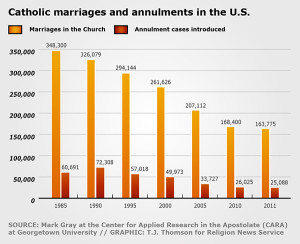
This is not intended as a “get out of jail free” card and should involve “a moral judgment of conscience that calls for serious personal reflection over a period of time,” as the Rev. James A. Coriden, a canon lawyer at the Washington Theological Union, put it in a detailed analysisin Commonweal magazine last year.
But if next October’s Vatican synod highlighted the “internal forum” option, church experts say it could go a long way toward teaching Catholics how an appeal to conscience can work, and could help remarried Catholics take part in church life without feeling like second-class citizens.
Three: Streamline the annulments process
Annulling a marriage in a church court can be a tortuous and expensive process that varies so widely from country to country that it raises questions of basic fairness. Indeed, two-thirds of the nearly 55,000 annulments granted by church tribunals around the world each year are in the U.S., even though American Catholics account for just 6 percent of the world’s Catholic population.
As Francis himself said, the process for annulments must be reviewed “because ecclesiastical tribunals are not sufficient.”
While the bishops who gather next fall could choose to adopt one or more of these three solutions, there are also powerful currents for maintaining the status quo.
For example, Roman officials have for years been trying to rein in annulments, not expand them, saying that tribunals — especially in the U.S. — are too quick to grant them.
Another warning sign: Amid rising speculation that change is coming, the Vatican’s top doctrinal official, Archbishop Gerhard Mueller, published a lengthy article in the Vatican newspaper on Oct. 22 that cast serious doubt on any prospects for reform.
Even an appeal to mercy for remarried Catholics — which Francis explicitly advocated — “misses the mark,” Mueller wrote in unusually direct language.
Given this pushback, said longtime Vatican watcher John Thavis, “it’s legitimate to wonder where the church is really headed: substantial change or another dead-end debate.”
Notes on coverage
Overview
Catholicism is a hierarchical religion, with authority vested in the pope, cardinals, bishops, priests and deacons. Information is relatively easy to find because everything is interrelated. That said, there are also dozens of Catholic organizations that are not officially part of the church. They include a range of Catholic charities, advocacy groups, and dissenting organizations.
Titles are particularly important in hierarchical religions and getting them right conveys a writer’s grasp of the church’s traditions. For example, don’t refer to a bishop or diocese when archbishop and archdiocese are the proper names.
Many issues in Catholicism are related to authority. Get a good understanding of what’s authoritative and what’s not. For example, a document issued by the Vatican may be considered binding on all Catholics, or it may not, depending on its purpose and who issued it. Authority is a sensitive issue that also affects whether people are labeled as dissenters who are violating church teaching or people who are working for change within the church.
Scripture
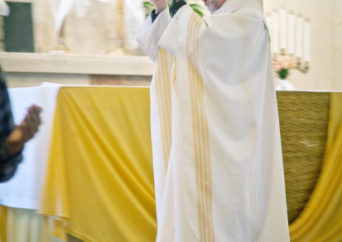
The U.S. Catholic Bishops use the New American Bible translation. Many Catholics also use the Catholic Study Bible or the New Revised Standard Version Catholic Edition.
The Catholic Church includes books of the Apocrypha in the biblical canon. (The Apocrypha, from the Greek word that means “things hidden,” is made up of religious writings included in the Septuagint, the Greek translation of the Old Testament, but not the Hebrew Bible. Roman Catholics and Orthodox accept them as divinely inspired, but Protestants do not.)
-
“The New American Bible”
Search through the Catholic Bible by book or verse.
Example coverage
When Catholic schools fire gay teachers, laity push back
By Lauren Markoe, Religion News Service
Oct. 7, 2013
(RNS) They taught English, gym, music and fifth grade, and are typically described as “beloved” by their students.
But that didn’t stop the Catholic schools where they worked from firing these teachers for their same-sex relationships, or, in one woman’s case, for admitting that she privately disagreed with church teaching on gay marriage.
A recent spate of sackings at Catholic institutions — about eight in the past two years — is wrenching for dioceses and Catholic schools, where some deem these decisions required and righteous, and others see them as unnecessary and prejudicial.
“Your typical Catholic school does have a mission and asks their teachers to be exemplars of what the schools are trying to do,” said Richard Garnett, a University of Notre Dame law professor who writes about religious freedom. “They’re trying to teach the church’s values about sexual ethics and morality.”
While the Catholic Church’s catechism requires Catholics to treat gays and lesbians with “respect” and “compassion,” it calls homosexual acts a “grave depravity,” and the church has been unequivocal in its rejection of gay marriage.
But among the signers of a petition to reinstate a gay teacher at St. Lucy’s Priory High School in Glendora, Calif., are alumni who say their school imparted other Catholic values that speak against the firing of Ken Bencomo. The head of the English department lost his job after 17 years at St. Lucy’s, after photos of his wedding appeared in a local newspaper.
“We all come from different backgrounds, different experiences, but I think a lot of people will agree when I say St. Lucy’s taught us to love each other and accept each other,” petitioner Allyssa DenDekker wrote. “John 3:16 ‘For God so loved the WORLD…’”
It’s not news that gay teachers and other employees of Catholic institutions lose their jobs over a same-sex relationship. Nor is it news that priests have sometimes quietly resisted pressure to fire gay employees. What’s different in recent years is a growing acceptance of gay marriage among Catholics, and gay people’s increasing ability to marry and unwillingness to hide their relationships.
The consequence, from a vocal swath of the laity, is a public pushback against Catholic institutions that fire gay employees who get married. Among the recent cases that rankled lay Catholics:
- Kristen Ostendorf, an English and religion teacher at Totino-Grace High School in Fridley, Minn., for 18 years. She lost her job this summer after acknowledging her lesbian relationship at a faculty meeting.
- Trish Cameron, a fifth-grade teacher at St. Joseph’s Catholic School in Moorhead, Minn., for 11 years. The school fired her in June 2012 after she told school officials that she supports gay marriage, though she keeps her views out of the classroom.
- Al Fischer, who taught music at St. Ann Catholic School in St. Louis for four years. St. Ann dismissed him in February 2012 after school officials learned of his plans to marry another man.
This summer, dozens of former students rallied outside St. Lucy’s and 75,000 people signed the petition to reinstate Bencomo; petitions are circulating in support of other teachers and lay leaders who faced similar fates.
One on behalf of Carla Hale garnered 100,000 signatures. Hale taught physical education at an Ohio Catholic school for 18 years and was fired in March after her mother’s obituary disclosed that Hale had a female partner. Hundreds of people called Bishop Watterson High School to protest Hale’s termination.
Supporters of Fischer decried his firing inletters to the editor of the St. Louis Post-Dispatch. Bloggers railed against the termination of Cameron.
Such firings — once the private affairs of Catholic schools, whispered about in the teachers’ lounge — now air on the nightly news and circulate on Facebook. Some progressive Catholics are hopeful that the public activism will help the church conclude that employing a gay person in a same-sex marriage comports with Catholic teaching.
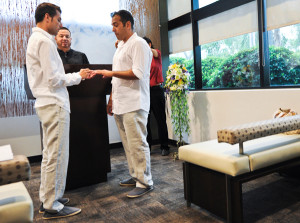
“What we know, what everyone knows, Catholic and non-Catholic, is that the younger generation is much more supportive of marriage equality than older generations, which is the indicator that it is the future,” said Frank DeBernardo, executive director of New Ways Ministry, a pro-gay Catholic group.
“I’m heartened by it not only because they’re young but because a lot of them have discussed their support for the teacher in terms of Catholic principles,” he said. “It’s a good case of the church hierarchy undone by their highest ideals.”
But the precarious situation of gay Catholic schoolteachers who marry is not likely to be undone soon, despite the laity’s support for gay marriage and Pope Francis’ increasingly warm comments about gay people.
The reality is that when churches and church schools terminate employees in same-sex relationships, they stand on firm legal ground. Religious institutions have a right, grounded in the First Amendment, to hire people who support their religious tenets and fire those who don’t.
It’s not just religious institutions where gay peoples’ jobs are vulnerable. Nationwide, 21 states and the District of Columbia prohibit discrimination on the basis of sexual orientation, with exemptions for religious institutions. Elsewhere, it’s perfectly legal to fire someone based on sexual orientation.
Still, bishops, priests and Catholic school principals are often reluctant to publicly defend decisions to fire gay teachers who have married. Those who do describe these decisions as painful but necessary.
After Hale lost her teaching job, Bishop Frederick Campbell spoke to The Columbus Dispatch about why she had to go: It’s his responsibility to maintain the Catholic identity of institutions he oversees, he said.
“We do this in an atmosphere of care, of calm consideration, but yet out of the realization that at particular times we have to make particular decisions,” Campbell said. “And they are difficult sometimes, but they do flow from what we believe, who we are and how we are to live.”
The Rev. Bill Kempf, pastor of the school from which music teacher Fischer was fired, explained to The Associated Press that Fischer’s union “opposes Roman Catholic teaching as it cannot realize the full potential a marital relationship is meant to express.”
Marianne Duddy-Burke, executive director of DignityUSA, an organization of gay, lesbian and transgender Catholics, hopes a different religious argument will someday make it OK for a person in a same-sex relationship to work openly in a Catholic school.
“The bishops’ hands are not tied,” she said. “You follow a man who died on a cross. And you’re promised resurrection — that’s the hallmark of our faith. If we can’t live that in our professional lives, how do we dare call ourselves Catholic?”
International sources
Canada
-
Gregory Baum
Gregory Baum is a professor emeritus in the religious studies department at McGill University in Montreal. His expertise is in social ethics and the sociology of religion. Catholicism is one area of focus within these topics.
-
Lorna Bowman
Lorna Bowman is a professor of religious studies at Brescia University in London, Ontario, Canada. Her research focuses on the intersection of religion and education, with an emphasis on Catholicism.
-
Daniel Cere
Daniel Cere is a professor of religious studies at McGill University in Montreal. He specializes in Catholic social thought and marriage and family. He is the author of “Marriage, Subordination and the Development of Christian Doctrine” from Does Christianity Teach Male Headship?
-
Terence J. Fay
Terence J. Fay is a lecturer on the History of Religion at the University of Toronto, Toronto, ON, Canada. He is an expert on the history of Catholicism.
-
Scott Kline
Scott Kline is an associate professor of religion at St. Jerome’s University in Waterloo, Ontario, Canada. His research interests include Catholic social thought, political theology and Christian ethics. He co-wrote a chapter for Religion and Conflict Resolution called “Catholic Peacemaking and Pax Christi.”
-
Geraldine Mossière
Geraldine Mossière is a professor of theology and religious studies at the Université de Montréal in Montreal, Quebec, Canada. She studies the anthropology of religion, religion and healing, new practices of Christianity in Quebec and religious mobility, among other topics. Her publications include “Quebec’s Catholicism through the Convert’s Eyes: why Islam is so much more attractive” published by the Association for the Sociology of Religion and “Critics of Catholicism in the Narratives of Quebecers Converts to Islam” published by the International Sociological Association Forum.
-
Tim Perry
Tim Perry was an associate professor of theology at Providence College and Seminary in Otterburne, Manitoba, Canada. He is the author of Mary for Evangelicals, Pope John Paul II: An Evangelical Assessment, Blessed Is She and Radical Difference: A Defense of Hendrik Kraemer’s Theology of Religions.
-
Megan Shore
Megan Shore is a professor of religious studies at King’s University College in London, Ontario, Canada. Her research focuses on Catholic social thought and on religion and conflict. With Scott Kline, she is co-writing a book titled Catholic Approaches to Just Peacemaking.
-
St. Francis Xavier University
St. Francis Xavier University in Nova Scotia, Canada has a Catholic Studies department. It offers a major and a minor, as well as a variety of elective courses.
United Kingdom
-
Archdiocese of Glasgow
The Archdiocese of Glasgow is the center of Catholic religious life in Glasgow. Rev. Philip Tartaglia is the archbishop.
-
Eileen Barker
Eileen Barker is a professor emeritus in the sociology department at the University of London. She studies minority religions, including cults, sects and New Religious Movements, and relevant social conditions.
-
Stephen Bullivant
Stephen Bullivant directs the Benedict XVI Centre for Religion and Society at St. Mary’s University in London, where he also teaches the theology and sociology of religion. He previously served as co-director of the international Nonreligion and Secularity Research Network.
-
Mark D. Chapman
Mark D. Chapman teaches church history, Catholicism, ecclesiology and Anglicanism at the University of Oxford. Chapman researches Anglican theology and church history.
-
Julie Clague
Julie Clague is a lecturer in theology and religious studies at the University of Glasgow. Her research focuses on Catholic moral and social thought and Christian approaches to public policy issues. She co-edits the journals Political Theology and Feminist Theology. She wrote the article “Christian conscience, Catholic teaching and lay participation in public life” in the International Journal of Public Theology.
-
David Fergusson
David Fergusson is a professor of divinity at the University of Edinburgh. His is director of the Scottish Journal of Theology. His research focuses on the relationship between church and society, Christian doctrine, and Christian history, with an emphasis on the history of Catholic and Reformed theology.
-
David Fincham
David Fincham is the director of theology and ethics at St. Mary’s University College in London. He is an expert on Catholic education and his publications include PSHCE in Catholic secondary schools: Stakeholders’ views and “Pastoral care in Catholic Schools,” which was published in The Pastoral Review.
-
David Grumett
David Grumett is Chancellor’s Fellow of Christian ethics and practical theology at the University of Edinburgh. His research focuses on French Catholic theology. He is the author of De Lubac: A Guide for the Perplexed.
Europe
-
Archdiocesi di Firenze
The Archiocesi di Firenze (Archdiocese of Florence) covers over 322 parishes and almost 840,000 Catholics. Giuseppe Betori is the archbishop.
-
Archdiocese of Prague
The Archdiocese of Prague is the administrative branch of the Catholic Church in Prague.
-
Catholic Church in the Czech Republic
The Catholic Church in the Czech Republic is the center of Catholic religious life in the Czech Republic. It is based in Prague.
-
Philippe Chenaux
Philippe Chenaux is a professor of church history and theology at Pontificia Universita Lateranense in Rome. His research interests include the history of the papacy, the history of the Vatican and the history of modern Catholic thought.
-
Barbiero Fernanda
Barbiero Fernanda is a professor of independent theology at Pontificia Universita Urbaniana in Rome. He teaches courses comparing Catholicism and Christian Orthodoxy and a course on the Trinitarian mystery.
-
Uto Meier
Uto Meier is a professor of religious education at Katholische Universitat Eichstätt-Ingolstadt in Germany. His research focuses on Catholic religious education.
-
Giovanni Tangorra
Giovanni Tangorra is a teacher of Ecclesiology and Mariology theology at Pontificia Universita Lateranense in Rome. His is also a priest of the Diocese of Palestrina. He collaborates frequently with Italian Catholic magazines.
Middle East
-
Catholic Church of the Holy Land
The Catholic Church of the Holy Land is the center of the Catholic community in Jerusalem. It is led by Rev. Giacinto-Boulos Marcuzzo.
Asia
-
Catholic Tokyo International Center
The Catholic Tokyo International Center supports Japan’s international Catholic community.
Latin America
-
Luiz Eduardo Waldemarin Wanderley
He is a sociology professor at the Catholic University of Sao Paulo. His research interests include the study of religions and ideologies. His authored works include Educate to Transform – Popular Education, The Catholic Church and Politics in the Basic Education Movement and Catholic Church and Politics in Brazil.
-
Eliane Muniz
Eliane Muniz is the press secretary for the National Council of Brazilian Bishops, which acts as the public voice of the Catholic Church in Brazil.
U.S. sources & resources
Major organizations
-
The Vatican
The official website of the Holy See.
-
U.S. Conference of Catholic Bishops
The U.S. Conference of Catholic Bishops has raised concerns about a range of freedom of conscience questions related to protection of life issues and supports including conscience provisions in proposed funding bills.
Faith media
-
Arlington Catholic Herald
The Arlington Catholic Herald is the official newspaper of the Roman Catholic Archdiocese of Arlington, Va. Michael F. Flach is the editor and general manager.
-
Bayou Catholic
Bayou Catholic is a magazine affiliated with the Diocese of Houma-Thibodaux in Louisiana.
-
Catholic Herald (Madison)
The Catholic Herald is the official newspaper of the Diocese of Madison, Wis.
-
Catholic Herald (Milwaukee)
The Catholic Herald is the official publication of the Archdiocese of Milwaukee.
-
Catholic Herald (Sacramento)
The Catholic Herald is the official magazine of the Catholic Diocese of Sacramento, Calif.
-
Catholic Herald (Superior)
The Catholic Herald is the official newspaper of the Diocese of Superior, Wis.
-
Catholic New York
Catholic New York is the largest Catholic newspaper in the United States. It is based in New York, N.Y.
-
Catholic News Agency
A privately funded online Catholic news provider focused primarily on the pope and happenings in the Holy See. Its sister agency is ACI Prensa in Lima, Peru.
-
Catholic Sentinel
The Catholic Sentinel is the official newspaper of the Archdiocese of Portland, Ore. It is the oldest Catholic newspaper on the West Coast. It is published bi-monthly by the Oregon Catholic Press.
-
Catholic Press Association
The Catholic Press Association of the United States & Canada is an association of newspapers and media specialists reporting on the Catholic Church. It is based in Chicago. Timothy Walter is the executive director. Contact through the website.
-
Catholic Review
The Catholic Review is affiliated with the Archdiocese of Baltimore. It is Maryland’s largest biweekly paid newspaper.
-
Catholic Star Herald
The Catholic Star Herald is the official newspaper of the Diocese of Camden, N.J.
-
Catholic Times
The Catholic Times is the official newspaper of the Catholic Diocese of Springfield, Ill.
-
Catholic Times (Columbus)
The Catholic Times is the official journal of the Roman Catholic Diocese of Columbus, Oh.
-
CatholicTV
CatholicTV is a national Catholic television network. It works to connect Catholics across the country. It is based in Watertown, Ma.
-
Catholic Universe Bulletin
The Catholic Universe Bulletin is a Catholic family newspaper based in Cleveland, Oh. Nancy Erikson is the editor.
-
Catholic Voice
The Catholic Voice is the official newspaper of the Archdiocese of Omaha, Neb.
-
Catholic World News
A Catholic news service staffed by lay Catholic journalists and owned by Trinity Communications.
-
Clarion Herald
The Clarion Herald is the official newspaper of the Archdiocese of New Orleans.
-
Denver Catholic Register
The Denver Catholic Register is a weekly newspaper published by the Archdiocese of Denver.
-
Catholic Courier
The Catholic Courier is the official newspaper of the Roman Catholic Archdiocese of Rochester, N.Y.
-
Diocese of Wilmington
The Diocese of Wilmington serves the Catholic communities of Delaware and Eastern Connecticut. Rev. W. Francis Malooly is bishop.
-
El Pueblo Catolico
El Pueblo Catolico is a weekly Spanish-language newspaper published by the Archdiocese of Denver. Contact through the website.
-
Hawaii Catholic Herald
The Hawaii Catholic Herald is the Diocese of Honolulu’s official newspaper. It is published every other Friday. Patrick Downes is editor.
-
Idaho Catholic Register
The Idaho Catholic Register is the official newspaper of the Roman Catholic Diocese of Boise, Idaho.
-
Intermountain Catholic
Intermountain Catholic is Utah’s official Catholic magazine. It is based in Salt Lake City.
-
Mississippi Catholic
The Mississippi Catholic is the newspaper of the Diocese of Jackson, Miss.
-
National Catholic Register
The National Catholic Register is a Catholic news service. It is based in Kettering, Ohio.
-
North Carolina Catholics
North Carolina Catholics is the online magazine of the Catholic Diocese of Raleigh, N.C.
-
North Country Catholic
North Country Catholic is the official newspaper of the Roman Catholic Archdiocese of Ogdensburg, N.Y. Mary Lou Kilian is the editor and general manager.
-
North Texas Catholic
The North Texas Catholic is a publication of the Roman Catholic Diocese of Forth Worth. Jeff Hensley is the editor.
-
Northwest Indiana Catholic
Northwest Indiana Catholic is the official newspaper of the Catholic Diocese of Gary, Ind.
-
Phaith
Phaith is the official magazine of the Catholic Archdiocese of Philadelphia. Matthew Gambino is the editor.
-
Pittsburgh Catholic
The Pittsburgh Catholic is the official newspaper of the Diocese of Pittsburgh.
-
Rhode Island Catholic
The Rhode Island Catholic is the official weekly newspaper of the Diocese of Providence. Rick Snizek is the editor.
-
South Texas Catholic
South Texas Catholic is the official publication of the Diocese of Corpus Christi, Tex.
-
Southern Cross
The Southern Cross is the newspaper of the Catholic Diocese of Savannah, Ga.
-
Southern Nebraska Register
The Southern Nebraska Register is the official newspaper of the Catholic Diocese of Lincoln, Neb.
-
St. Cloud Visitor
The St. Cloud Visitor is the official newspaper for the Catholic Diocese of St. Cloud, Minn. Bob Zyskowski is the editor.
-
St. Louis Review
The St. Louis Review is the official publication of the Catholic Archdiocese of St. Louis, Mo.
-
Tennessee Register
The Tennessee Register is the official publication of the Roman Catholic Diocese of Nashville, Tenn.
-
Texas Catholic Herald
The Texas Catholic Herald is the semi-monthly official publication of the Archdiocese of Galveston-Houston.
-
The Beacon
The Beacon is the official publication of the Roman Catholic Diocese of Paterson, N.J.
-
The Boston Pilot
The Boston Pilot is the official newspaper of the Archdiocese of Boston, and America’s oldest Catholic newspaper.
-
The Catholic Accent
The Catholic Accent is the official publication of the Diocese of Greensburg, Penn.
-
The Catholic Advance
The Catholic Advance is the official newspaper of the Catholic Diocese of Wichita, Ks. Christopher M. Riggs is the editor.
-
The Catholic Free Press
The Catholic Free Press is a publication serving Catholics in the Diocese of Worcester, Mass.
-
The Catholic Miscellany
The Catholic Miscellany is the official newspaper of the Diocese of Charleston, S.C. Deidre Mays is the editor.
-
The Catholic Missourian
The Catholic Missourian is the official newspaper of the Catholic Diocese of Jefferson City, Mo. Jay Nies is the editor.
-
The Catholic Moment
The Catholic Moment is the official newspaper of the Catholic Diocese of Lafayette in Indiana. Kevin Cullen is the editor.
-
Northwest Catholic
Northwest Catholic is the official publication of the Archdiocese of Seattle. Greg Magnoni is the editor.
-
The Catholic Post
The Catholic Post is the newspaper of the Catholic Diocese of Peoria, Ill.
-
The Catholic Spirit (Charleston)
The Catholic Spirit is the official publication of the Diocese of Wheeling-Charleston in West Virginia. Colleen Rowan is the editor.
-
The Catholic Standard
The Catholic Standard is the weekly newspaper for the Archdiocese of Washington. Its main office is located in Silver Spring, Md.
-
The Catholic Sun
The Catholic Sun is the official newspaper of the Diocese of Rochester, N.Y.
-
The Criterion
The Criterion is the weekly official newspaper of the Archdiocese of Indianapolis. Michael Krokos is the editor.
-
The Florida Catholic
The Florida Catholic is the official newspaper for the Roman Catholic Archdiocese of Miami and the dioceses of Orlando, Palm Beach and Venice.
-
The Georgia Bulletin
The Georgia Bulletin is the newspaper of the Catholic Archdiocese of Atlanta.
-
The Globe
The Globe is the official newspaper of the Catholic Diocese of Sioux City, Ia.
-
The Long Island Catholic
The Long Island Catholic is the official magazine of the Catholic Diocese of Rockville Centre. It is based in Roosevelt, N.Y.
-
The Michigan Catholic
The Michigan Catholic is a publication of the Archdiocese of Detroit.
-
The Observer
The Observer is the official newspaper of the Catholic Diocese of Rockford, Ill.
-
The Record
The Record is the weekly publication of the Archdiocese of Louisville, Ky. Glenn Rutherford is the editor.
-
The Southern Cross
The Southern Cross the official newspaper of the Catholic Diocese of San Diego.
-
The Southwest Kansas Register
The Southwest Kansas Register is the official newspaper of the Catholic Diocese of Dodge City, Ks.
-
The Texas Catholic
The Texas Catholic is the official newspaper of the Diocese of Dallas.
-
The Tidings
The Tidings is the Catholic weekly publication of Southern California. It is based in Los Angeles.
-
West Nebraska Register
The West Nebraska Register is the official publication of the Catholic Diocese of Grand Island, Neb.
Other sources
-
America Magazine
A Jesuit national Catholic weekly magazine in the United States.
-
Catholic Almanac
An almanac published annually by Our Sunday Visitor.
-
Catholic News Service
A well-respected news service that is owned and funded by U.S. bishops.
-
Commonweal
Commonweal is a politics and ethics journal edited and managed by lay Catholics.
-
Crisis Magazine
An independent journal from a more conservative viewpoint.
-
Glenmary Research Center
The Glenmary Research Center supports and assists Glenmary Home Missioners by providing applied research to Glenmary leadership, individual missioners, church leaders and the wider society.
-
National Catholic Reporter
A print and web news source for Catholics covering complex moral and societal issues.
-
Our Sunday Visitor
Our Sunday Visitor is a popular Catholic news weekly viewed as conservative.
-
The Catholic Encyclopedia
This online encyclopedia is the 1917 version. Journalists should be aware that it contains no updates, such as church reforms made during Vatican II and should not be relied upon for current information.
-
The Official Catholic Directory
Published by P.J. Kenedy & Sons. The Official Catholic Directory is a guide to Catholic clergy in the United States and around the world.
-
U.S. Catholic
A church run magazine for lay Catholics.
Related source guides
-
Pastoral leadership: crisis and opportunity
-
Eighteen fresh ideas to spice up your December holiday reporting
-
Hollywood translates The Da Vinci Code
-
The push for more – or less – politicking from churches
-
Homosexuals and the Catholic priesthood
-
A guide to covering abortion issues
-
29 story ideas for Lent, Easter and Passover
-
Animal rites: The Feast of St. Francis is Oct. 4
-
School vouchers and the separation of church and state
